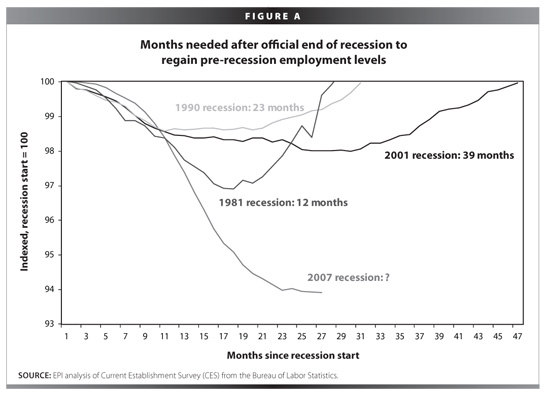EPI News - April 1, 2010
Labor market faces threat of a prolonged jobless recovery
The March unemployment report being released on Friday is widely expected to show the most job growth in three years, in large part due to the hiring of temporary Census workers. While news of job growth will be welcome, it will not diminish the risk of a largely jobless recovery.
In their new paper, For Job Seekers, No Recovery in Sight, economists Josh Bivens and Heidi Shierholz explore the recent trend of jobless recoveries and explain why unemployment will probably remain high for years, even though the official end of the recession most likely occurred in the middle of 2009.
The authors outline what they describe as "an excruciatingly long lag time" between economic recovery and improved job prospects, which has characterized some of the most recent periods of so-called economic recovery. While it took 12 months after the recession of 1981 to return to pre-recession levels of employment, that time span almost doubled -- to 23 months -- after the 1990 recession, and rose again -- to 39 months -- after the recession of 2001.

Using those three past recessions to project job growth in the current recovery, Bivens and Shierholz conclude that even under the most hopeful scenario -- a 1981-style recovery -- employment will not return to pre-recession levels until September 2011. And if the current recovery looks more like the past two periods of slow post-recession job growth, it could take until 2013 or 2014 to get employment levels back to where they were before the Great Recession began. The paper recommends strong policy interventions to help ensure that GDP growth corresponds with job growth.
Good for workers, good for business
Many American workers who manage to form unions remain unable to bargain for a first contract in a timely manner, often because employers fail to bargain in good faith or use stalling tactics to preserve the status quo. One key tool to help workers avoid this impasse is first contract arbitration, which gives both the union and the employer the option of entering binding arbitration after 90 days of unsuccessful contract talks and 30 days of mediation.
A new analysis by EPI Vice President Ross Eisenbrey looks at collective bargaining over a seven-year period in the Canadian province of Manitoba, where first contract arbitration has been used regularly. Eisenbrey found that first contract arbitration had no effect on business success or survival. His findings run contrary to the claims of business lobbyists and conservative critics that first contract arbitration would cause businesses to close. Even in places where first contract arbitration is law, Eisenbrey found it is rarely used, but serves a valuable purpose of deterring both workers and employers from bargaining in bad faith. First contract arbitration is a key provision of the Employee Free Choice Act.
BLS follows EPI's lead in highlighting ratio of job seekers to job openings
Last month, the Bureau of Labor Statistics (BLS) published a report showing that during the current recession, the ratio between unemployed job seekers and job openings had reached its highest level since BLS began the Job Openings and Labor Turnover Survey (JOLTS) in 2000. The ratio peaked last November with 6.2 unemployed workers per job opening, and then slipped to 5.4 in January, the latest month for which data are available.
EPI has been far ahead in calculating this ratio. In August 2002, EPI issued its first analysis of the ratio, which is based on the seasonally adjusted employment level from the Current Population Survey and the seasonally adjusted job openings data from the JOLTS survey.
Our monthly tracking of these data has provided key evidence showing that jobs are not always readily available, even to persistent job seekers. During the current jobs crisis, EPI economist Heidi Shierholz' regular analysis of the monthly JOLTS data provided an early indication of the severity of this downturn. As EPI President Lawrence Mishel has said on numerous occasions, the current situation for the unemployed "is a cruel game of musical chairs with at least five unemployed workers circling each job opening."